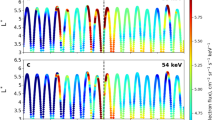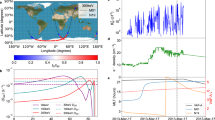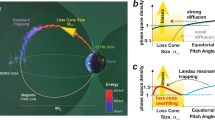Abstract
Recent analysis of satellite data obtained during the 9 October 2012 geomagnetic storm identified the development of peaks in electron phase space density1, which are compelling evidence for local electron acceleration in the heart of the outer radiation belt2,3, but are inconsistent with acceleration by inward radial diffusive transport4,5. However, the precise physical mechanism responsible for the acceleration on 9 October was not identified. Previous modelling has indicated that a magnetospheric electromagnetic emission known as chorus could be a potential candidate for local electron acceleration6,7,8,9,10, but a definitive resolution of the importance of chorus for radiation-belt acceleration was not possible because of limitations in the energy range and resolution of previous electron observations and the lack of a dynamic global wave model. Here we report high-resolution electron observations11 obtained during the 9 October storm and demonstrate, using a two-dimensional simulation performed with a recently developed time-varying data-driven model12, that chorus scattering explains the temporal evolution of both the energy and angular distribution of the observed relativistic electron flux increase. Our detailed modelling demonstrates the remarkable efficiency of wave acceleration in the Earth’s outer radiation belt, and the results presented have potential application to Jupiter, Saturn and other magnetized astrophysical objects.
This is a preview of subscription content, access via your institution
Access options
Subscribe to this journal
Receive 51 print issues and online access
$199.00 per year
only $3.90 per issue
Buy this article
- Purchase on Springer Link
- Instant access to full article PDF
Prices may be subject to local taxes which are calculated during checkout



Similar content being viewed by others
References
Reeves, G. D. et al. Electron acceleration in the heart of the Van Allen radiation belts. Science 341, 991–994 (2013)
Green, J. C. & Kivelson, M. G. Relativistic electrons in the outer radiation belt: differentiating between acceleration mechanisms. J. Geophys. Res. 109, A03213 (2004)
Chen, Y., Reeves, G. D. & Friedel, R. H. W. The energization of relativistic electrons in the outer Van Allen belt. Nature Phys. 3, 614–617 (2007)
Ukhorskiy, A. Y., Sitnov, M. I., Takahasi, K. & Anderson, B. J. Radial transport of radiation belt electrons due to stormtime Pc5 waves. Ann. Geophys. 27, 2173–2181 (2009)
Perry, K. L., Hudson, M. K. & Elkington, S. R. Incorporating spectral characteristics of Pc5 waves into three-dimensional modelling and the diffusion of relativistic electrons. J. Geophys. Res. 110, A03215 (2005)
Horne, R. B. & Thorne, R. M. Potential wave modes for electron scattering and stochastic acceleration to relativistic energies during magnetic storms. Geophys. Res. Lett. 25, 3011–3014 (1998)
Summers, D., Thorne, R. M. & Xiao, F. Relativistic theory of wave-particle resonant diffusion with application to electron acceleration in the magnetosphere. J. Geophys. Res. 103, 20487–20500 (1998)
Summers, D. et al. Model of the energization of outer-zone electrons by whistler-mode chorus during the October 9, 1990 geomagnetic storm. Geophys. Res. Lett. 29, 2174–2197 (2002)
Horne, R. B. et al. Wave acceleration of electrons in the Van Allen radiation belts. Nature 437, 227–230 (2005)
Thorne, R. M. Radiation belt dynamics: the importance of wave-particle interactions. Geophys. Res. Lett. 37, L22107 (2010)
Baker, D. N. et al. The relativistic electron-proton telescope (REPT) instrument on board the Radiation Belt Storm Probes (RBSP) spacecraft: characterization of Earth’s radiation belt high-energy particle populations. Space Sci. Rev. 179, 337–381 (2013)
Li, W. et al. Constructing the global distribution of chorus wave intensity using measurements of electrons by the POES satellites and waves by the Van Allen probes. Geophys. Res. Lett. 40, 4526–4532 (2013)
Baker, D. N. et al. Coronal mass ejections, magnetic clouds, and relativistic magnetospheric electron events: ISTP. J. Geophys. Res. 103, 17279–17291 (1998)
McPherron, R. L. & Baker, D. N. Factors influencing the intensity of magnetospheric substorms. J. Atmos. Terr. Phys. 55, 1091–1122 (1993)
Shue, J.-H. et al. Magnetopause location under extreme solar wind conditions. Geophys. Res. Lett. 103, 17691–17700 (1998)
Kletzing, C. A. et al. The Electric and Magnetic Field Instrument Suite and Integrated Science (EMFISIS) on RBSP. Space Sci. Rev. 179, 127–181 (2013)
Meredith, N. P. et al. Global models of lower band and upper band chorus from multiple satellite observations. J. Geophys. Res. 117, A10225 (2012)
Li, W. et al. Global distribution of whistler-mode chorus waves observed on the THEMIS spacecraft. Geophys. Res. Lett. 36, L09104 (2009)
Li, W. et al. THEMIS analysis of observed electron distributions responsible for chorus excitation. J. Geophys. Res. 115, A00F11 (2010)
Ni, B., Thorne, R. M., Shprits, Y. Y. & Bortnik, J. Resonant scattering of plasma sheet electrons by whistler-mode chorus: contributions to diffuse auroral precipitation. Geophys. Res. Lett. 35, L11106 (2008)
Nishimura, Y. et al. Identifying the driver of pulsating aurora. Science 330, 81–84 (2010)
Thorne, R. M., Ni, B., Tao, X., Horne, R. B. & Meredith, N. P. Scattering by chorus waves as the dominant cause of diffuse auroral precipitation. Nature 467, 943–946 (2010)
Kennel, C. F. & Petschek, H. E. Limit on stably trapped particle fluxes. J. Geophys. Res. 71, 1–28 (1966)
Blake, J. B. et al. The Magnetic Electron Ion Spectrometer (MagEIS) instruments aboard the Radiation Belt Storm Probes (RBSP) spacecraft. Space Sci. Rev. 179, 383–421 (2013)
Horne, R. B. et al. Timescales for radiation belt electron acceleration by whistler mode chorus waves. J. Geophys. Res. 110, A03225 (2005)
Kataoka, R. & Miyoshi, Y. Magnetosphere inflation during the recovery phase of geomagnetic storms as an excellent magnetic confinement of killer electrons. Geophys. Res. Lett. 35, L06S09 (2008)
Turner, D. L., Shprits, Y., Hartinger, M. & Angelopoulos, V. Explaining sudden losses of outer radiation belt electrons during geomagnetic storms. Nature Phys. 8, 208–212 (2012)
Horne, R. B. et al. Gyro-resonant electron acceleration at Jupiter. Nature Phys. 4, 301–304 (2008)
Li, W. et al. Global distribution of wave amplitudes and wave normal distributions of chorus waves with high-resolution THEMIS wave observations. J. Geophys. Res. 116, A12205 (2011)
Sheeley, B. W., Moldwin, M. B., Rassoul, H. K. & Anderson, R. R. An empirical plasmasphere and trough density model: CRRES observations. J. Geophys. Res. 106, 25631–25641 (2001)
Acknowledgements
This work was supported by JHU/APL contracts 967399 and 921647 under NASA’s prime contract NAS5-01072. The analysis at UCLA was supported by the EMFISIS sub-award 1001057397:01 and by the ECT sub-award 13-041. We thank OMNIweb for providing geomagnetic indices and solar wind parameters used in this study and the NOAA POES team for providing POES electron data.
Author information
Authors and Affiliations
Contributions
R.M.T. developed the project, directed the theoretical analysis, and was mainly responsible for writing the paper. W.L. conducted the data analysis on electrons and chorus waves and helped construct the global model of chorus. B.N. developed the method to infer wave intensity using POES electron data, performed the wave modelling, and evaluated the diffusion coefficients. Q.M. performed the Fokker–Planck simulations. J.B. and L.C. assisted with the global wave modelling. D.N.B. and S.G.K. provided the REPT data. H.E.S. and G.D.R. led the RBSP-ECT energetic particle team and G.D.R. and M.G.H. provided the phase space density. M.G.H. was responsible for the electron pitch angle data. C.A.K., W.S.K. and G.B.H. provided the EMFISIS wave data. J.B.B., J.F.F. and S.G.C. provided the MagEIS data.
Corresponding author
Ethics declarations
Competing interests
The authors declare no competing financial interests.
Extended data figures and tables
Extended Data Figure 1 Bz , SYM-H and evolution of ratios (30–100 keV) in various MLT sectors.
a, The z component of the interplanetary magnetic field in the GSM coordinate. b, SYM-H index. c–h, The ratio (colour coded) of precipitated and trapped electron fluxes (30–100 keV) measured by multiple POES satellites in six distinct MLT sectors. The grey shaded region represents the time interval in which the simulation was performed.
Extended Data Figure 2 Electron diffusion rates due to chorus scattering at L = 5.
Drift and bounce averaged electron pitch angle diffusion coefficients (colour coded) ( , a–d), momentum diffusion coefficients (
, a–d), momentum diffusion coefficients ( , e–h), and mixed (pitch angle, momentum) diffusion coefficients (
, e–h), and mixed (pitch angle, momentum) diffusion coefficients ( , i–l) for four ut intervals during the observed electron acceleration event, based on the parameters shown in Extended Data Table 1.
, i–l) for four ut intervals during the observed electron acceleration event, based on the parameters shown in Extended Data Table 1.
Extended Data Figure 3 Spline fitting of the observed electron PSD data.
The red solid line represents the spline fitting result, and the ‘plus sign’ data points represent the observed electron phase space density at ∼90° pitch angles from both MagEIS and REPT two hours before 20:00 ut on 8 October 2012, when Van Allen probe B travelled through L ≈ 5.
Extended Data Figure 4 Schematic illustration of local electron acceleration by chorus.
The top panel shows electron fluxes before (left) and after (right) the storm. The injection of low-energy plasma sheet electrons into the inner magnetosphere (1) causes chorus wave excitation in the low-density region outside the cold plasmasphere (2). Local energy diffusion associated with wave scattering leads to the development of strongly enhanced phase space density just outside the plasmapause (3). Subsequently, radial diffusion can redistribute the accelerated electrons inwards or outwards from the developing peak (4).
Supplementary information
Supplementary Information
This file contains: Supplementary Section SI, a more detailed description of how the global wave amplitudes of chorus emissions is constructed from the ratio of precipitated to trapped (30–100 keV) electron flux obtained from POES spacecraft data; Supplementary Section S2, a detailed description of how electron diffusion coefficients using available data on the global wave characteristics of chorus and the global distribution of plasma density were constructed and Supplementary Section S3, additional information on the boundary conditions and the initial electron distribution used in the 2D simulation. (PDF 350 kb)
Rights and permissions
About this article
Cite this article
Thorne, R., Li, W., Ni, B. et al. Rapid local acceleration of relativistic radiation-belt electrons by magnetospheric chorus. Nature 504, 411–414 (2013). https://doi.org/10.1038/nature12889
Received:
Accepted:
Published:
Issue Date:
DOI: https://doi.org/10.1038/nature12889
This article is cited by
-
Relativistic electron flux growth during storm and non-storm periods as observed by ARASE and GOES satellites
Earth, Planets and Space (2023)
-
Whistler-mode chorus waves at Mars
Nature Communications (2023)
-
Whistler-mode waves in Mercury’s magnetosphere observed by BepiColombo/Mio
Nature Astronomy (2023)
-
Plasma Environment, Radiation, Structure, and Evolution of the Uranian System (PERSEUS): A Dedicated Orbiter Mission Concept to Study Space Physics at Uranus
Space Science Reviews (2023)
-
The Electric and Magnetic Fields Instrument Suite and Integrated Science (EMFISIS): Science, Data, and Usage Best Practices
Space Science Reviews (2023)
Comments
By submitting a comment you agree to abide by our Terms and Community Guidelines. If you find something abusive or that does not comply with our terms or guidelines please flag it as inappropriate.



